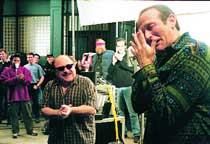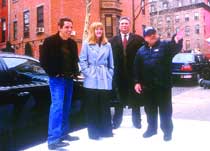
Danny DeVito (left), pictured on the set of Smoochy directing Robin Williams: "Let's get all the material, stick it in the machine and make a great movie."
|
Freedom - that's what it's all about," says Danny DeVito in regard to how digital filmmaking has changed the way he works as a director. DeVito is a Hollywood veteran; an actor, director and producer who has not only embraced the digital revolution, but has become part of it. While working on his Death to Smoochy (2002), he and a friend sat down at his dining room table and created the film's opening sequence using Mac G3s and Adobe's After Effects and Photoshop. It helps that this friend is technophile Kerry Brown, a music producer/engineer who has worked on a variety of musical titles, including some for Smashing Pumpkins, and has directed several music videos for MTV. The chameleon-like Brown has recently thrown himself into digital visual effects.
DeVito wanted the open to resemble the start of a kids' show. It features some greenscreen footage as well as animated still photos of Robin Williams' character and his sidekick, Angelo Pike, dancing and spinning.
DeVito, who likes getting his hands dirty - so to speak, with computer software - says having After Effects and Photoshop as tools "is so valuable because it gives you the freedom to explore and experiment."
It was his knowledge of what the software can do that led him to call Kerry Brown with the idea for the Smoochy open. "We played with various concepts that I had and it wasn't a long process," explains DeVito. "It was just a matter of doing several temps and then we went final. There's some spinning animated things I did with one of the characters. I didn't go back and shoot anything except for a couple of stills of [the character] Angelo Pike turning in eight or 10 different positions."

After teaching themselves After Effects and Photoshop, DeVito and Brown created this Smoochy open on Mac G3 laptops. Click to Enlarge
|
Recently, DeVito took some time out from the post production phase of his February 2003 release Duplex, a black/romantic comedy starring Ben Stiller and Drew Barrymore, to talk about how he looks at filmmaking and how his hands-on use and knowledge of the latest technology have helped hone his craft.
How did you first start using Adobe products?
I'm a Final Cut Pro fan, and am always playing with my computer. I just started playing with [After Effects] trying to learn it. I have a very good friend, Kerry Brown, who's into it. I was always intending on trying to do digital movies. For a long time I've been talking at [my company] Jersey Films and trying to figure out a way to give myself and other filmmakers I know that avenue, that freedom to do it.
I just finished [shooting] a movie, 35mm, at Miramax called Duplex. I'm trying to apply as much as I can to that. I have the desire; it gives you the freedom. The creative process, the channels are totally opened up by it. And it's so much fun - my 14-year-old son Jake plays around with it.

DeVito is currently in post on Duplex, which stars (L-R) Ben Stiller, Drew Barrymore and Harvey Fierstein.
|
How does being hands-on with these products change the way you look at filmmaking and the way you direct?
There are so many different aspects to directing/moviemaking. How you conduct yourself on set, preproduction when working on the movies, the choices you make. The fact that you have that [technology] opens up other channels. You can try things, take more chances and realize things in a much more immediate way using Adobe.
How do you decide what you can actually do on your own, in your dining room, as opposed to going to a visual effects studio?
When I work with Kerry and the people at Coldwater Studio [Kerry Brown's place] I rely heavily on their technical expertise. I have the boldness to say let's do this or let's do that. I just keep pushing and trying to figure out ways to apply it, but I don't have the total chops that some of these guys have.

DEVITO DIRECTING CREDITS
|
What about the film you are working on now, Duplex?
I'm playing on my Final Cut but editing on an Avid. And I'm trying to figure out ways to apply digital technology in any way I can to the movie. It's a different set of circumstances. It's a romantic comedy. I have some bluescreen, but there's not a lot of animation and things like that… unless I come up with a title sequence I'd like to do.
So, as a director it gives you even more control?
Yeah, absolutely. I work with Lynzee Klingman, who is a brilliant editor. She did War of the Roses, Hoffa, Matilda and is now editing Duplex with me. Everybody is aware of the fact that times are changing and people are [using] the digital editing process. I first worked with Lynzee on a Kem, then we went to Lightworks and now we're on Avid. I'm a big advocate of trying to free up and go - let's be able to edit anywhere we want on our Final Cut.
So that's your future?
Yes, definitely, the future. I hope that one day I could do an entire Final Cut Pro movie. I know there are people doing it now. I think Steven Soderbergh did one [with Full Frontal]. It's a great thing to have on your laptop - to go wherever you want. I think that Avid is trying to make some adjustments... I guess everybody looks at the best of everybody's system and tries to emulate them.
Yes, Avid came out with Xpress DV 3 to go head-to-head with Final Cut Pro. Is that something you would like to get your hands on, too? I like to try everything, absolutely.
I've seen you on the exhibit floor at tradeshows, like the NAB, in the past. I didn't go this year, I've been working on many things, so I didn't get a chance, but I like all the gadgets. Getting in there and finding out what makes them tick. I love that everybody is so free about it. I hope that continues.
Despite having hands-on knowledge of this kind of technology, most of your films have been dialogue- and story-driven. Do you ever imagine doing a full-out effects film?
It's not out of the question. We always talk about it at Jersey. We just concentrate on, like you said, story-driven projects that are about real characters. I think the great thing is to try to figure out ways to apply it to that, to see if we could blend the two and give ourselves the freedom to create.
So are you interested in shooting a completely digital film?
Absolutely. I'm really interested in that. Kerry and I are always talking about it. We just have to figure out the right story and put it together. But we have the tools and the freedom to do it. We just have to come up with the right story.
Did you see the digital version of Star Wars? What did you think?
Yes, there's a guy [George Lucas] that is using every ounce of digital information. I thought he did a good job. I enjoy George's experimentations, always.
Where are you are in the production cycle with Duplex?
We are smack in the middle of editing. I'm really excited about it. The performances are really, really good... Drew and Ben. I would imagine that in a few weeks I'll have a cut to show. So I'm getting very close. Just putting temp music in and playing around with stuff now. And I'll wrap up the editing end of summer and have it ready for February.
You said you might play around with the title sequence?
Yeah, I'm doing it all the time. Shooting stuff in New York, putting it together and trying to figure out things like that. That's the great thing about being able to go out and shoot with a digital camera and put it right on your laptop. It doesn't have to be earmarked for a title sequence. We could throw a montage inside or something.
I was playing around with [Pinnacle] Commotion for a while, but you really have to get in there and use it every day. You really have to rely on the experts. I would love to be able to just get on it and move things around like you do in Photoshop.
This technical knowledge must help you during shooting if you are having difficulty getting a shot, saying, "I know I could do this."
Yes! It is a psychological leg up. I guess you can do anything; anything you can dream of or anything you could think of - you just want to get it to look good. I've spoken to people at the Orphanage [in San Francisco] and places like that, and I've done work with people at ILM, and everybody is working toward that goal - to try to make things look as real and natural as possible, and still give you the freedom to put things in, take them out, move them around, flip them over... Let's get all the material, stick it in the machine and make a great movie. Freedom. That's what it's all about.